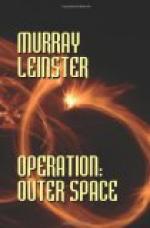“The field’s always a pipe, a tube, a column of stressed space between the field-plates,” Jones reminded him. “When we landed the first time, back yonder, the tail of the ship wasn’t in the field at all. The field stretched from the bow of the ship only, out to that last balloon we dropped. We were letting down at an angle to that line. It was like a kite and a string and the kite’s tail. The string was the Dabney field, and the directions we were heading was the kite’s tail.”
Cochrane nodded. It occurred to him that Jones was very much unlike Dabney. Jones had discovered the Dabney field, but having sold the fame-rights to it, he now apparently thought “Dabney Field” was the proper technical term for his own discovery, even in his own mind.
“Back on the moon,” Jones went on zestfully, “I wasn’t sure that a field once established would hold in atmosphere. I hoped that with enough power I could keep it, but I wasn’t sure—”
“This doesn’t mean much to me, Jones,” said Cochrane. “What does it add up to?”
“Why—the field held down into atmosphere. And we were out of the primary field as far as the tail of the ship was concerned. But this time we landed, I’d hooked in some ready-installed circuits. There was a second Dabney field from the stern of the ship to the bow. There was the main one, going out to those balloons and then back to Earth. But there was—and is—a second one only enclosing the ship. It’s a sort of bubble. We can still trail a field behind us, and anybody can follow in any sort of ship that’s put into it. But now the ship has a completely independent, second field. Its tail is never outside!”
Cochrane did not have the sort of mind to find such information either lucid or suggestive.
“So what happens?”
“We have both plates of a Dabney field always with us,” said Jones triumphantly. “We’re always in a field, even landing in atmosphere, and the ship has practically no mass even when it’s letting down to landing. It has weight, but next to no mass. Didn’t you notice the difference?”
“Stupid as it may seem, I didn’t,” admitted Cochrane. “I haven’t the least idea what you’re talking about.”
Jones looked at him patiently.
“Now we can shoot our exhaust out of the field! The ship-field, not the main one!”
“I’m still numb,” said Cochrane. “Multiple sclerosis of the brain-cells, I suppose. Let me just take your word for it.”
Jones tried once more.
“Try to see it! Listen! When we landed the first time we had to use a lot of fuel because the tail of the ship wasn’t in the Dabney field. It had mass. So we had to use a lot of rocket-power to slow down that mass. In the field, the ship hasn’t much mass—the amount depends on the strength of the field—but rockets depend for their thrust on the mass that’s thrown away astern. Looked at that way, rockets shouldn’t push hard in a Dabney field. There oughtn’t to be any gain to be had by the field at all. You see?”




